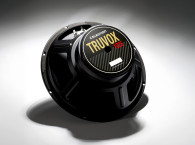
SHANNON BECKER: What can you tell us about your background?
MANUEL PODSZUS: I was born in 1958 and graduated from high school at the age of 17. After obtaining a degree in mechanical engineering from the Berlin Technical University, I worked freelance for companies including Bosch (now operating as Bosch Rexroth AG), Mercedes-Benz, Faulhaber Motoren, which supply customers in industry the world over, and Mannesmann. My tasks included blueprinting, developing and designing assembly and measuring apparati as well as automation units. I also worked as a business consultant. I try to always use cutting-edge technology. For instance, I designed a mounting device for 3-D measurements on car doors, which require extremely low tolerances, for Daimler AG. Later, I was active in the field of micro-robot technology. In everything, I strive to find the perfect solution.
SHANNON: Describe your first personal loudspeaker project. Why did you build it?
MANUEL: When I was a teenage music enthusiast, I built compact loudspeakers with four Podszus-Görlich midbass drivers, which are still in use to this very day. After that, I built two acoustic transducers which had 12 Podszus-Görlich midbass drivers each. In my quest for audiophile perfection, I always wanted to turn my vision into reality. Using the money I earned while working during my course of study, I bought my first hi-fi system, which I always wanted to be state of the art.

Zellaton’s founder,
is pictured in 1956.
SHANNON: In 2005, you filed a patent for a conveyor system with a shunt. Where did the idea originate?
MANUEL: I inherited the inventive spirit of my grandfather, Dr. Emil Podszus, who owned more than 100 patents. I view seemingly unsolvable problems as a challenge. I focus on ingeniously simple solutions such as the shunt in the conveyor system you just mentioned. Companies appreciate my unorthodox approach to solving problems and my extremely high success rate in implementing my solutions.
SHANNON: Your grandfather, a German physicist and inventor, also founded ZELLATON. How has this influenced your interest in the audio world?
MANUEL: Many of my grandfather’s inventions related to loudspeakers and diaphragms. He was a visionary. What I strive for is to put them into practice by building on his legacy: the best possible musical reproduction with a fun factor. Music is an experience that reaches deep inside us—an experience I want to enable all music aficionados to have.

company logo is shown.
SHANNON: When did you join ZELLATON and what role do you play in the company?
MANUEL: ZELLATON has been in existence since the middle of the 1930s, and I have been refining this unique technology for more than 30 years. Michael Schwab and I are the company’s shareholders and managing directors of ZELLATON GmbH—a capacity in which I am in charge of research and development.

1950s is shown in front and back views.
SHANNON: Tell us about ZELLATON’s first product. How did it come about, and is it still sold today?
MANUEL: The ZELLATON One was our first project—a fantastic loudspeaker with a smart, clean-cut cabinet and my newly developed driver. Its highlight is the full-cone tweeter featuring a Podszus rigid foam diaphragm, which I succeeded in readying for mass production after decades of at times nerve-wracking work. This model was modified based on an extensive market study and now lives on as the Grand.

SHANNON: ZELLATON has introduced major technological and design innovations. Can you give us a few examples?
MANUEL: I examined the full complement of components, optimizing and modernizing them in countless test series. Examples that come to mind are the CAD-engineered neodymium magnet system and the high-temperature coil made of titanium foil.
Naturally, I primarily focused on the Podszus ZELLATON diaphragm, which I improved considerably by using modern materials and sophisticated, purpose-designed processes without changing the basic formulation that had been used for decades. Only by paying painstaking attention to ensuring that all the basic conditions are met during the production process can one guarantee the foam’s optimal structure, which is characterized by miniscule bubbles and extremely high rigidity. Manufacturing the extremely lightweight diaphragm for the full-cone tweeter was a real challenge, but achieving a linear frequency response proved to be a virtually insurmountable hurdle—especially when it came to ensuring its stability in mass production. Just like the product itself, the materials used for the surround and the spider are the result of years of research and the selection of an adhesive optimized for each individual application. We conducted numerous experiments and held one listening session after another to determine the optimal position for the drivers within the acoustic baffle as well as the type and amount of filler used in the cabinet. Further information can be found in detailed descriptions on our website (www.zellaton.com).

a three-way, five driver system with
three cone woofers, one cone tweeter,
and one cone midrange.
MANUEL: By resolutely refining the originally patented subject matter, we have achieved a sensational level of sound quality that thrills music listeners the world over. We believe that ZELLATON is an investment for life.
SHANNON: Are you currently working on or planning any new audio innovations?
MANUEL: Of course, I’m working on several new ideas at the moment, and I’m already putting them through various series of tests. But that’s all I’m revealing for now!

SHANNON: Can you recommend any useful new parts or promising technologies to audioXpress readers?
MANUEL: If I had to choose just one, I would recommend Schnerzinger Technologies (www.schnerzinger.com). For more than three decades the Schnerzinger team has been scientifically working on new methods of energy transmission and developing ways to clear up of interfering fields. Now they apply their scientific findings to develop audio products.
SHANNON: Where do you see the audio industry in the next few years?
MANUEL: One field in which I believe significant progress will be made is high-resolution data formats.






